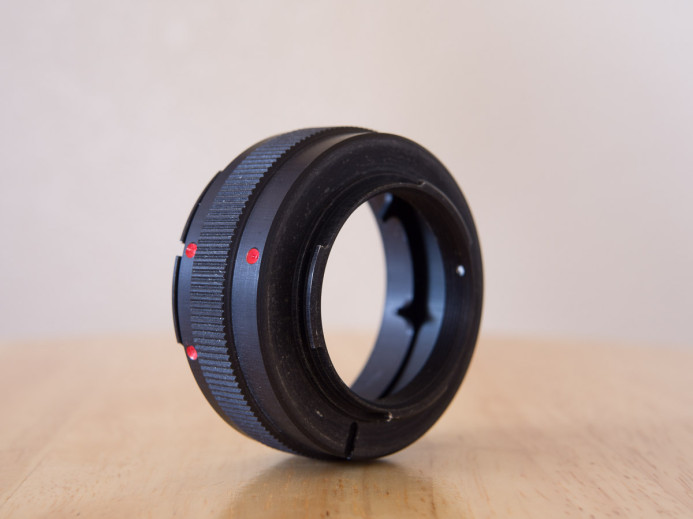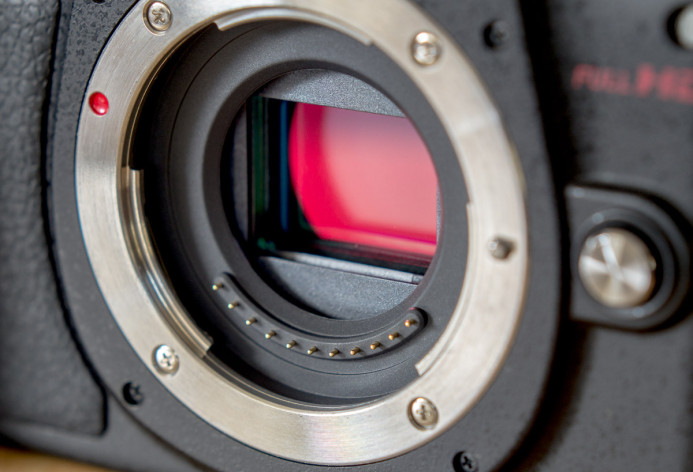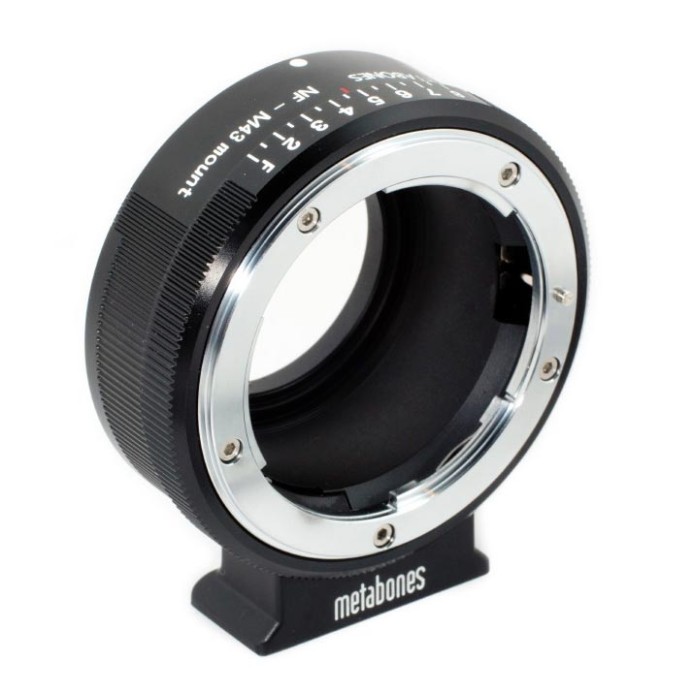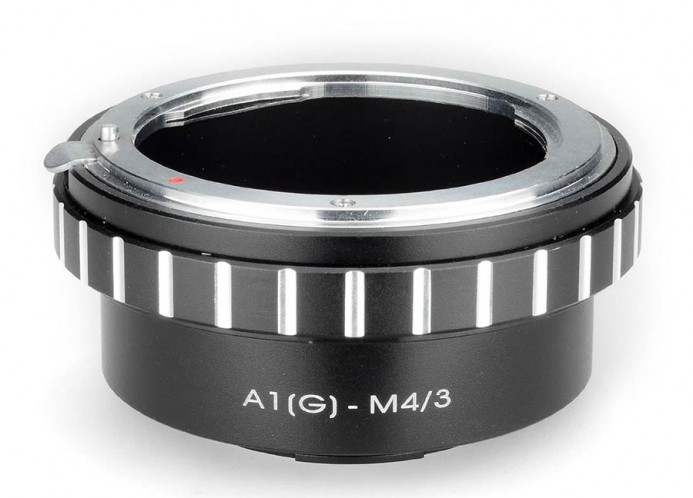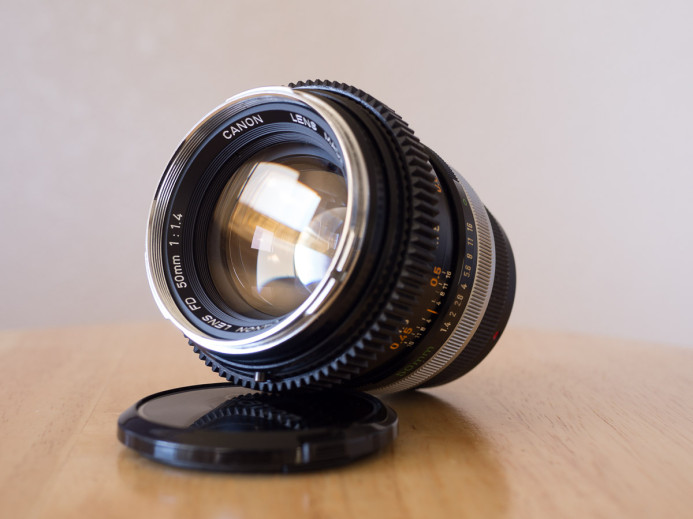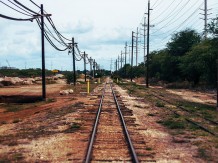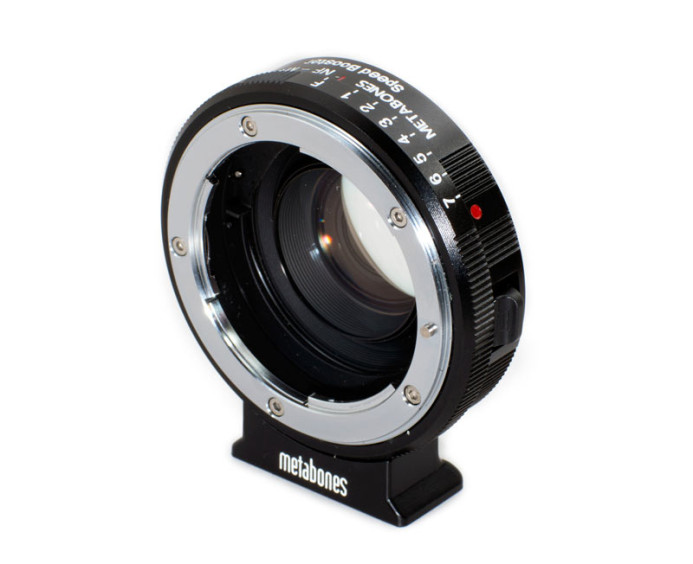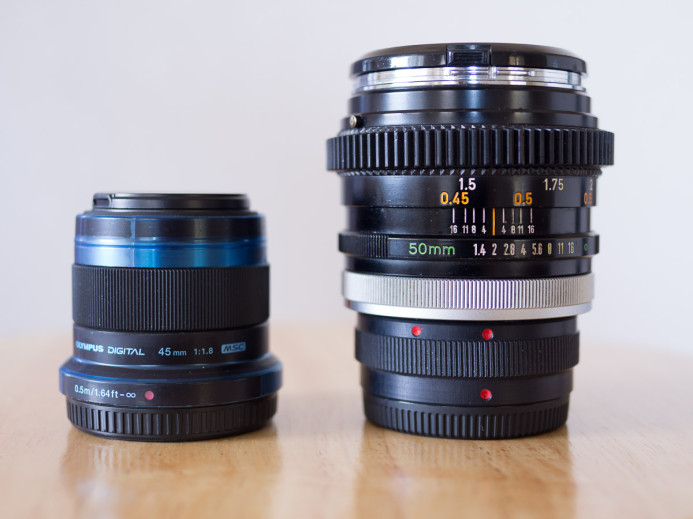Adapting Lenses for the Panasonic GH4
The Panasonic GH4’s Micro Four Thirds (MFT) mount may just be the most versatile lens mount on the planet. Virtually any lens under the sun can be attached to this mount.
All you need is the right adapter.
That’s why this post is all about one of the GH4’s greatest strengths– using adapted lenses.
Any Lens? How can this be?
Here’s the deal: Because the Panasonic GH4 is a mirrorless camera, the lens mount can be positioned much closer to the sensor than on a standard DSLR (which needs to fit an articulating mirror in between). The distance between the lens mount and the camera’s sensor is referred to as the flange focal distance (FFD).
Simply put, any lens that is built for a camera with larger FFD than MFT (i.e. the lens mount is positioned farther from the sensor) can be adapted for use on the GH4. The adapter acts as a spacer that fills in the gap between the MFT mount and the FFD that the lens was built for.
Quick example:
- Micro Four Thirds FFD: 19.25mm
- Nikon F FFD: 46.50mm
- Difference: 27.25mm
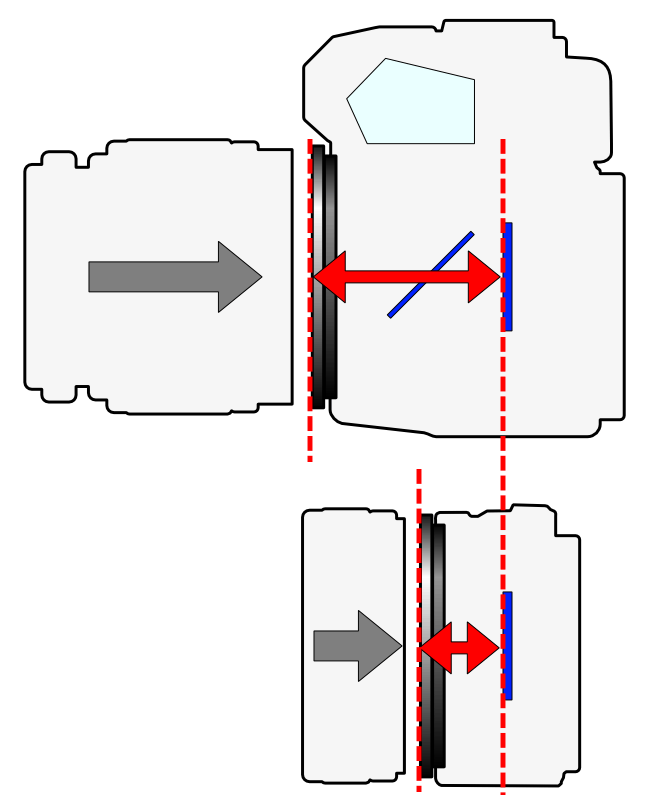
SLR FFD compared to MFT FFD (by Shigeru23)
Since the FFD of the Nikon F mount is greater than MFT’s FFD, you can use Nikon lenses on the GH4 with an adapter that positions the lens 27.25mm away from the GH4’s lens mount.
Adapters for All
Adapters for a wide array of lens mounts are readily available for the Panasonic GH4.
- Nikon F/G lenses? Easy.
- How about a Canon FD lens from the 1970’s? Sure.
- PL mount? Yup.
- C-mount lenses from defunct security cameras? Indeed.
- Surely not Canon EF lenses though? But of course.
The list goes on and on– if you have a lens, there is likely an adapter to use it on the GH4’s MFT mount.
Selecting an Adapter
While an adapter might merely be a spacer between a lens and camera, it still needs to be precise. If the adapter is not precisely built, then the distance between the lens and the camera will be wrong, causing issues with image quality and focus. This is why it’s important to use quality adapters.
Thankfully, a quality adapter does not need to break the bank. Here are a few places where you can get quality adapters at affordable prices:
- Ciecio7 Adapters (eBay) — Excellent build quality for a number of different lens mounts including Canon FD, C-mount, B4, and PL.
- Metabones — A bit more expensive than Ciecio7, but offers adapters for additional lens mounts such as Nikon F/G, Leica M/R, and Contax.
A Different Approach: Budget Adapters
While I would not recommend using budget adapters for mission-critical work, they should not be ruled out entirely. For example, if you just want to experiment with an old lens, a budget adapter is a good option.
I’ve been testing this inexpensive “Zebra” Nikon G adapter that costs less than $15.
My copy has a nice tight fit with no play and a smooth clickless aperture ring. If you have some Nikon mount lenses and you want to test them out on the GH4, I’d recommend checking out the budget adapter one before dropping $140 on the Metabones adapter.
The Metabones adapter likely has better build-quality, better quality control, and tighter tolerances, but for your uses, the budget adapter may be all you need.
Also, while a Ciecio7 C-mount adapter (eBay) ($42) will surely be well made, the price is a bit steep when some C-mount lenses sell for half that. For example, you can get a 35mm f/1.7 C-mount lens with an MFT adapter for $25 all said and done. I’d recommend getting the lens/adapter combo first before picking up the more expensive adapter. You’ll probably be just fine with the included adapter.
Benefits of Adapted Lenses
So you can use pretty much any lens on the Panasonic GH4 with an adapter. That’s nice, but what’s the big deal? Why should you care?
Because depending on your shooting needs, adapted lenses could offer huge benefits.
Manual Control
While there are a few exceptions, adapted lenses will be fully manual on the GH4. This means you have full control over the lens– no autofocus hunting, no fly-by-wire focus rings, and no fiddling with DOF previews. You set the aperture and the focus directly on the lens.
Video shooters in particular will welcome manual control over focus that enables them to set focus marks and consistently repeat them.
Some manual lenses have a clickless aperture that allows you to smoothly stop down or open up a lens when lighting conditions change. This is extremely useful for run-and-gun shooting where you have no control over the environment.
Access to Vintage Lenses
When you enter the world of adapted lenses, your lens catalog grows exponentially.
The Panasonic GH4’s MFT mount is relatively new, so you don’t have decades of lenses for this mount like you do with other mounts like Nikon, Canon FD, or C-mount.
However, with the aid of adapters, you gain access to this huge back catalog of vintage lenses, some of which were considered defunct prior to the introduction of the GH4’s MFT mount.
When Canon introduced the EF mount, decades of FL and FD mount lenses suddenly became obsolete. As users upgraded to new camera models, these “legacy” lenses became unusable.
Now, using an adapter, you can mount some amazing glass on the GH4 that rivals Canon’s latest lenses, but at a fraction of the price. One of my favorite lenses– a Canon FD 50mm f/1.4 “Chrome Nose”– renders a beautiful image and cost me less than $30.
What can you do with a 45-year old $30 lens? Plenty.
Go Wide with the Metabones Speed Booster
Metabones recently introduced a special lens adapter called the Speed Booster. This adapter uses specially-designed optics to give your existing lenses a wider field of view (FOV) on the Panasonic GH4, which can make a big difference when space is tight.
The Speed Booster’s optics reduce the image from the lens to better fit on the GH4’s sensor. As a result, instead of MFT’s normal 2x crop factor, the GH4 will have a 1.42x crop factor with the Speed Booster. This results in a wider FOV than even APS-C cameras (1.6x crop factor).
In fact, it’s pretty close to Super 35’s 1.39x crop factor, which is great for those coming from a cinema background.
Faster Lenses
Oh yeah, thanks to the optical design, the Speed Booster also makes your lenses 1 stop faster. This means your lenses will be twice as bright on the GH4 compared to using a standard adapter.
Double the Fun
If making your lenses wider and faster is not enough, you can also get a second focal length from each lens by switching between a standard adapter and a Speed Booster.
For example, let’s say you have a single 5omm lens:
- Standard adapter: 100mm equivalent FOV (2x crop factor)
- Speed Booster: 71mm equivalent FOV (1.42x crop factor)
So even if you had only one lens, you can drastically change its FOV simply by switching adapters. Pretty cool, huh?
This is why I recommend using manual lenses with a non-MFT mount when possible. MFT lenses mount directly to the GH4– no adapter required– meaning you lose out on the benefits of using adapters like the Speed Booster.
Further Reading
Standardize
Adapters are great, but juggling between a dozen different adapters to switch lenses is no fun. To minimize the number of different adapters you need to keep track of, I recommend standardizing your arsenal of lenses on a single lens mount.
Furthermore, despite my love for Canon FD lenses, I recommend standardizing on the Nikon F/G mount because of its versatility, availability, and quality.
Versatility
Nikon’s mount has one of the largest FFDs of any mount, making it adaptable to any lens mounts with a shorter FFD. For example, here are some camera mounts that can be adapted to use Nikon F/G lenses:
- Nikon — All models.
- Micro Four Thirds — Panasonic GH4/GH3, Olympus OMD, etc.
- Canon EF/EF-S — 5D MKIII, 7D, T5i, etc.
- Sony A-Mount/E-Mount — FS700, FS100, A7s, etc.
- Sony FZ-mount — F55, F5
- RED
By standardizing on Nikon lenses, your lens collection will not be locked to a single camera system. Nikon lenses will continue to be adaptable to other cameras now and into the future.
Availability
Lenses for the Nikon F mount has been around for over 50 years. Even Nikon’s newer G mount is compatible with F mount lenses.
With that much history, there’s a huge selection of used Nikon glass available on sites like eBay and KEH.
On top of that, most modern 3rd-party lenses are available with a Nikon mount, so you have even more options when selecting lenses.
Quality
Nikon lenses are well known for their high image quality. Many cinematographers swear by Nikon lenses, even using them on RED cameras for feature films.
Need More Input?
For more information on using Nikon lenses, here’s an informative video by Caleb Pike:
Final Decision: Native or Adapted?
Both native and adapted lenses have some great benefits; choosing between them can be difficult.
Native lenses are small, light, have autofocus, and are tuned specifically for MFT cameras like the Panasonic GH4.
Adapted lenses provide full manual control, repeatable focus, unique character, and are also a bit more future-proof than native MFT lenses.
My recommendation: use both. There’s no reason not to. If a native lens meets your requirements, use it. If you need repeatable focus and hard stops for video work, grab a manual lens and the necessary adapter for the GH4.
I shot solely with adapted lenses (mostly Canon FDs) for several years on the Panasonic GH1, GH2, and GH3. Recently I’ve picked up a couple native lenses from Panasonic and Olympus, which I enjoy using as well.
The truth is you have access to so much goodness, why limit yourself? Enjoy the benefits of both native and adapted lenses.
In the end, which lens you choose comes down to what you’re shooting– a native or adapted lens may be a better fit depending on the situation.
Digging Deeper
Now that you are up to speed on the two main groups of lenses available for the Panasonic GH4, you’re ready to dig deeper into the vast world of lens options. Other posts in this series focus on specific lens options for various shooting situations. Here is a sample of the topics covered in upcoming guides in the series:
- Choosing a lens for video production
- Lenses for documentaries
- Primes vs Zooms
- Building A Complete Set of Primes
- The Best Zoom Lens
- Going wide (wide angle lens options)
- And more!
By the end of this series, you’ll be a lens expert for the Panasonic GH4!
The series is continually updated with new guides, so sign up below to get the latest posts in this series delivered directly to your inbox and send me a tweet to let me know about any specific topics you would a guide on.
Free Consult
Are you excited about the potential of the Panasonic GH4 and its versatile Micro Four Thirds lens mount, but feel overwhelmed by all the options?
The Panasonic GH4’s MFT system may be completely new territory for a many of you. It’s such a versatile system that it can all be a bit hard to digest.
I’ve been shooting on the MFT system and Panasonic’s GH-series cameras for several years and I want to help you find your bearings quickly so you can get back to shooting awesome stuff! That’s why I’m currently offering free consults to help answer your questions.
Related
- Get the Panasonic GH4 — It’s here, it’s awesome, get it and go shoot.
- Metabones Speed Booster — Increase the field of view and speed of your lenses with this adapter.
- Flange Focal Distances of Different Mounts
- eBay — A great place to find new and used lenses for the Panasonic GH4.
- KEH — Another marketplace for buying and selling used lenses.
Lens Options for the Panasonic GH4
Introduction
- Micro Four-Thirds: Introduction & Overview
- Using Native Lenses
- Using Adapted Lenses
- How to Choose Your First Lens
Canon EF Lenses
- Using Canon EF Lenses
- Review: 7 Days with Metabones’ Canon EF Speed Booster
- Speed Booster Showdown: Canon EF vs Nikon
- PSA: Canon EF-S is not the Same as APS-C
Prime Lenses
- 5 Reasons You Should Be Using Prime Lenses
- 9 Awesome Prime Lenses (Wide Angle to Telephoto)
- Essential Prime Lenses for Your Documentary
Zoom Lenses
- 4 Reasons Zoom Lenses are Awesome for the Panasonic GH4
- Lens Throwdown: Panasonic 12-35mm f/2.8 vs Olympus 12-40mm f/2.8
Buying Guides
More Panasonic GH4 Guides
- Why You Should Be Excited About the Panasonic GH4
- Lenses for the Panasonic GH4 — Awesome glass for an awesome camera.
- Memory Cards for the Panasonic GH4 — Get the right memory cards for HD and 4K.
- Configuring the Panasonic GH4 for Video Production — Set the GH4 up for filmmaking.
- Rigging the Panasonic GH4 — Cages, Rigs, Components, Gear, and Reviews.
- Stabilizing the Panasonic GH4 — Tripods, Monopods, Sliders, 3-Axis Gimbals, etc.
- Maximizing the Panasonic GH4’s Audio Performance — Sound matters.
- Powering the Panasonic GH4 — Keep the GH4 shooting all day.
- Should you buy the YAGH for the Panasonic GH4?
- 6 Reasons Why DSLR Shooters Love the Panasonic GH4
